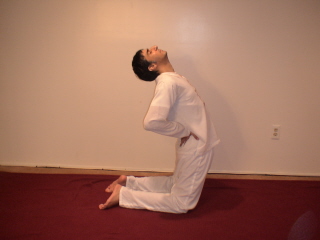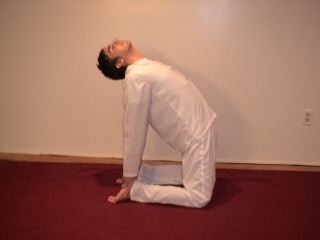Free Online Hatha Yoga Poses Galleries
 Free Pictures of Hatha Yoga Poses
Free Pictures of Hatha Yoga Poses
Hatha Yoga Illustrated Postures
Welcome to the Free Online Hatha Yoga Galleries. These poses are the basis of many types of yoga and this online book is going to house an ongoing collection of these important postures and exercises. This book will complement the Free Online Illustrated Kundalini Yoga Exercises E-book, which focuses on the Kundalini Yoga Poses available on the website.
These hatha yoga galleries are going to reflect those poses that are specific to hatha yoga, and from this page you will find links to all the detailed online articles. Please note those postures that are a part of both kundalini yoga and hatha yoga are linked to from both books. As new poses are added to the website they are linked to from this page, so this is a good page to bookmark if you are interested in learning and mastering Hatha Yoga.
The yoga poses from this book are used extensively in the Free Online Yoga & Meditation Classes that are offered on this website. Those classes integrate yoga, meditation and pranayama to deliver a particular result, feel free to eexplore them by clicking the above link.
The layout of the book is as follows:
The book is divided into sections, each of which is a gallery of a particular category of hatha yoga poses. Such as seated poses, standing poses, inverted postures, etc. As new movements and techniques are added to the website, they are placed in the particular gallery they belong to and are then linked to from this page.
Each linked chapter contains the following details:
- Background and overview of that particular exercise.
- Step by step instructions of how to practice that technique.
- Benefits and cautions for each posture.
- Practice tips to help you develop mastery.
- Fully illustrated modification when available for that technique.
Hatha Yoga Galleries
CLICK ON THE LINK BELOW TO BE TAKEN TO THE CHAPTER WILL ALL THE DETAILS FOR THAT POSE.
Recommended Reading Before You Begin:
Beginner’s Guide to Yoga Practice
Seated Poses
Best Yoga Posture for Meditation (Butterfly Pose)
Yoga Cat-Cow Pose for Emotional Health
Lion Pose to Detox & Cleanse the Body
Tantra Yoga Practice of Vajroli for Sex Chakra Balancing
Nauk Yoga Asana to Get Firm Toned Abs
Lower Back Exercise – Yoga Spinal Twists
Tantric Position for Sexual Potency (Kundalini Lotus Pose)
Advanced Tantric Exercise Video to Channel Sex Energy (Maha Bandha)
Post Natal Yoga Exercise for Weight Loss
Yoga Exercises for Neck Pain
Yoga Exercise for Beginners | Yoga Rowing
Basic Yoga Stretch for Flexibility | Cradle Rock
Yoga Cow Pose to Release Tension
Standing Poses
Archer Pose for Confidence (Akarna Dhanur Asana)
Mountain Yoga Position for Nerve Strength
Easy Yoga Pose for Stretching and Warming Up (Palm Tree Posture)
Triangle Yoga Pose for Flexibility and Strength
Office Yoga Exercise for Lower Back Pain
Supine Poses
Cobra Pose Illustration for Healthy Back (Bhujang Asana)
Hatha Yoga Plank Pose for Strong Arms
Hatha Yoga Corpse Pose for Relaxation and Healing
Hatha Yoga for Liver Detox & Digestive Power
Simple Yoga for Upper Body Strength
Tough Power Yoga Pose – Elbow Platform
More Free Yoga Postures | Bridge Pose for Strengthening Back
Powerful Yoga Ab Crunches to Get Six Pack Abs
Yoga Exercise for Root Chakra | Frog Pose
Inverted Poses
Shoulder Stand Pose for Brain Fitness (Sarvanga Asana)
Plough Pose for Opening Key Chakra Points (Hal Asana)
Backward Bending Poses
Camel Pose Illustration for Digestive System (Ushtra Asana)
Advanced Yoga Technique for Total Workout (Wheel Pose)
Yoga Bow Pose for Eternal Youth (Dhanur Asana)
Hatha Yoga Modified Wheel Pose for Digestion & Flexibility
Classical Hatha Yoga Asana – Locust Pose
Forward Bending Poses
Back Stretching Pose (Forward Bend) for Spontaneous Healing
Baby Pose to Clam and Relax the Mind
Miscellaneous Poses
Crane Pose (Advanced Pose from Hatha Yoga Book)
Don’t forget to check out the free online yoga and meditation classes and the other free online e-books and videos offered on this website.
Donation for Free Hatha Yoga Galleries:
Although the collection is completely free and will remain so, this work is supported by donations from all of you. In Yogic Philosophy, the student presents the teacher with a donation (Guru Dakshana) in exchange for the teaching she/he receives and this closes the Karmic Loop and completes the Energy Exchange. This entire website is based on this philosophy and therefore all content is free. A donation is not required, but is appreciated.
To donate please visit the following page. Thank you and God Bless You.
Click here to Donate to Mastery of Meditation & Yoga
More free Hatha Yoga Poses coming soon…











